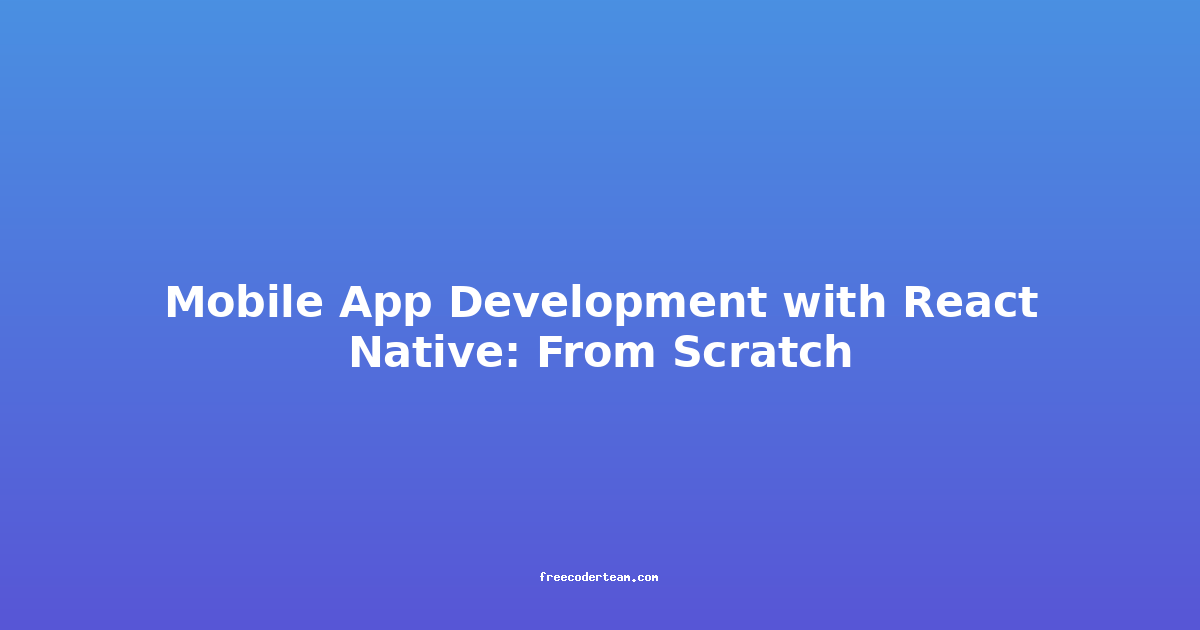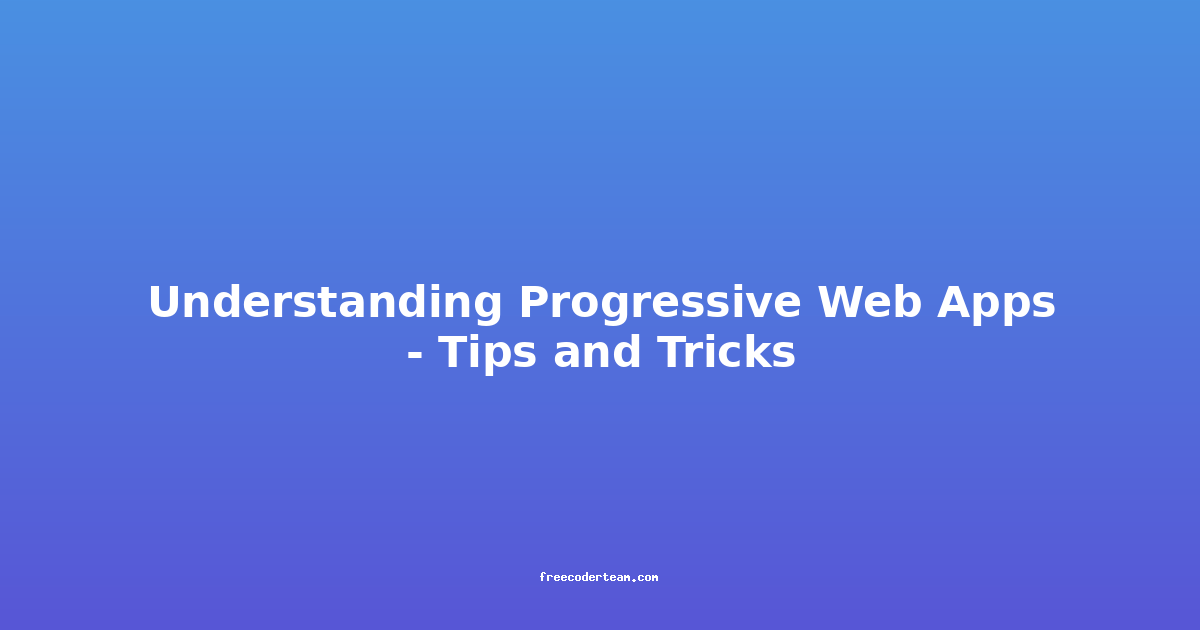Mobile App Development with React Native: From Scratch
React Native is one of the most popular frameworks for building cross-platform mobile applications. It allows developers to write native apps for both Android and iOS using JavaScript and the React library, making it an attractive choice for building high-quality, performant apps with a single codebase. In this comprehensive guide, we'll walk through the process of building a mobile app from scratch using React Native, covering setup, development best practices, and actionable insights.
Table of Contents
- Introduction to React Native
- Setting Up Your Development Environment
- Creating Your First React Native App
- Building a Simple To-Do List App
- Best Practices for React Native Development
- Tips and Tricks for Efficient Development
- Conclusion
Introduction to React Native
React Native is a JavaScript framework for building native mobile applications. It uses the same principles as React for web development, allowing developers to reuse skills and code across platforms. Unlike web apps, React Native compiles to native code, meaning your app will perform as well as one built entirely with Java/Kotlin (Android) or Swift/Objective-C (iOS).
Key Features of React Native:
- Cross-Platform Development: Write once, deploy on both Android and iOS.
- Native Performance: Leverages native UI components for smooth performance.
- Large Community and Ecosystem: Access to thousands of open-source libraries and tools.
- Hot Reloading: Instantly see changes in your app during development.
Setting Up Your Development Environment
Before diving into app development, you need to set up your environment. Here's what you'll need:
Prerequisites:
- Node.js: React Native requires Node.js. Install it from nodejs.org.
- expo-cli (Optional): If you plan to use Expo, which simplifies React Native development.
- Android Studio (for Android development):
- Download and install from developer.android.com.
- Xcode (for iOS development):
- Install Xcode from the Mac App Store if you're on macOS.
- React Native CLI: Install globally using npm or yarn:
npm install -g react-native-cli # or yarn global add react-native-cli
Setting Up Expo (Optional)
Expo is a popular tool that simplifies React Native development by handling the native codebase for you. Install the Expo CLI:
npm install -g expo-cli
Creating Your First React Native App
Let's create a new React Native project. We'll use the react-native-cli to create a basic app.
Step 1: Create the Project
Open your terminal and run:
npx react-native init MyApp
This command initializes a new React Native project named MyApp.
Step 2: Navigate to the Project Directory
cd MyApp
Step 3: Run the App
To run the app, you have two options:
Option 1: Using Expo (If Installed)
If you're using Expo, run:
expo start
This will launch the Expo development interface, and you can scan the QR code with your phone to view the app.
Option 2: Running on a Device or Emulator
If you prefer running the app natively:
- Android: Use Android Studio's emulator or connect a real device.
- iOS: Use Xcode's simulator or connect a real device.
Run:
npx react-native run-android
or
npx react-native run-ios
You should now see a basic React Native app with the default "Welcome to React Native!" screen.
Building a Simple To-Do List App
Now that we have the basics set up, let's build a simple To-Do List app to practice React Native concepts.
Step 1: Update the App Structure
Inside the App.js file, let's create a basic todo list app. Start by importing necessary components:
import React, { useState } from 'react';
import { View, Text, StyleSheet, TextInput, Button, FlatList } from 'react-native';
const App = () => {
const [todos, setTodos] = useState([]);
const [input, setInput] = useState('');
const addTodo = () => {
if (input.trim()) {
setTodos([...todos, input]);
setInput('');
}
};
const removeTodo = (index) => {
const updatedTodos = todos.filter((_, i) => i !== index);
setTodos(updatedTodos);
};
return (
<View style={styles.container}>
<Text style={styles.title}>To-Do List</Text>
<TextInput
style={styles.input}
placeholder="Add a new task..."
value={input}
onChangeText={setInput}
/>
<Button title="Add Task" onPress={addTodo} />
<FlatList
data={todos}
keyExtractor={(item, index) => index.toString()}
renderItem={({ item, index }) => (
<View style={styles.todoItem}>
<Text>{item}</Text>
<Button title="Remove" onPress={() => removeTodo(index)} />
</View>
)}
/>
</View>
);
};
const styles = StyleSheet.create({
container: {
flex: 1,
padding: 20,
backgroundColor: '#fff',
},
title: {
fontSize: 24,
fontWeight: 'bold',
marginBottom: 20,
},
input: {
borderWidth: 1,
borderColor: '#ccc',
padding: 10,
marginBottom: 10,
borderRadius: 5,
},
todoItem: {
flexDirection: 'row',
justifyContent: 'space-between',
alignItems: 'center',
padding: 10,
borderBottomWidth: 1,
borderBottomColor: '#ccc',
},
});
export default App;
Explanation:
- State Management: We use
useStateto manage the list of todos and the input field. - Add Task: The
addTodofunction adds a new task to the list and clears the input field. - Remove Task: The
removeTodofunction removes a task based on its index. - FlatList: We use
FlatListto render the list of tasks dynamically.
Step 2: Run the App
Start the app using:
npx react-native run-android
or
npx react-native run-ios
You should see a simple To-Do List app with the ability to add and remove tasks.
Best Practices for React Native Development
To build efficient and maintainable React Native apps, follow these best practices:
1. Use Linting and Formatting
Install ESLint and Prettier to enforce consistent code formatting:
npm install --save-dev eslint prettier eslint-config-prettier eslint-plugin-import eslint-plugin-react
Create a .eslintrc file:
{
"extends": ["prettier", "eslint:recommended", "plugin:react/recommended"],
"rules": {
"prettier/prettier": "error"
}
}
2. Modularize Your Code
Break your app into reusable components. For example:
// components/TodoItem.js
import React from 'react';
import { View, Text, Button } from 'react-native';
const TodoItem = ({ task, onRemove }) => (
<View style={{ flexDirection: 'row', justifyContent: 'space-between', alignItems: 'center', padding: 10, borderBottomWidth: 1, borderBottomColor: '#ccc' }}>
<Text>{task}</Text>
<Button title="Remove" onPress={onRemove} />
</View>
);
export default TodoItem;
3. Use Hooks for State Management
For simple state management, useState and useEffect are sufficient. For more complex state, consider using Redux or Context API.
4. Optimize Performance
- Use
PureComponentorReact.memofor components that don't need to re-render unnecessarily. - Implement
shouldComponentUpdateoruseMemo/useCallbackfor performance-critical parts.
5. Use Expo for Quick Prototyping
Expo simplifies the development process by abstracting away the native build process. It's ideal for prototyping and rapid development.
Tips and Tricks for Efficient Development
1. Use Hot Reloading
React Native supports hot reloading, which instantly reflects changes in your app. To enable it, run:
npx react-native start --reset-cache
2. Debugging
- Use Chrome DevTools for debugging by running:
ornpx react-native log-androidnpx react-native log-ios - Debug on a real device for better performance testing.
3. Use Vector Images
React Native provides the Image component, but for better performance, use vector images or SVGs with libraries like react-native-svg.
4. Leverage Native Modules
For platform-specific features, use native modules. React Native provides many built-in modules, and you can also create custom modules using React Native CLI.
5. Use Keyboard Handling
The keyboard often covers input fields on iOS and Android. Use libraries like react-native-keyboard-aware-scroll-view to handle this gracefully.
Conclusion
React Native is a powerful framework for building cross-platform mobile apps. By following the steps outlined in this guide, you can set up your environment, create a basic app, and build a functional To-Do List app. Remember to follow best practices and leverage tools like Expo and linting to streamline your development process.
With React Native, the possibilities are endless. Whether you're building a simple app or a complex enterprise solution, the framework's flexibility and performance make it a top choice for modern mobile development.
Happy coding! 🚀
If you have any questions or need further assistance, feel free to reach out! 😊




